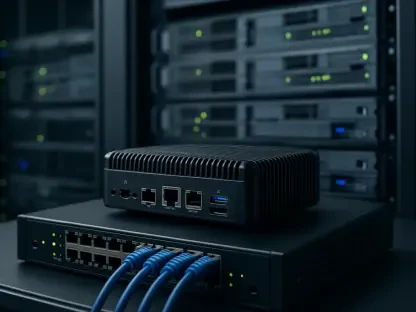The landscape of data center networking is undergoing a seismic shift as artificial intelligence (AI) workloads skyrocket, demanding unprecedented speed, reliability, and scalability. With global data center spending projected to surge from $430 billion this year to $1.1 trillion by 2029, the pressure is on to innovate networking solutions that can keep pace with AI’s insatiable appetite for data. This roundup dives into diverse perspectives from industry leaders, analysts, and technology vendors to uncover how AI is transforming networking infrastructure. The purpose here is to synthesize varied opinions, tips, and reviews on cutting-edge advancements, vendor strategies, and market trends, offering a comprehensive view of this dynamic field.
Exploring the AI and Data Center Nexus: A Foundation for Change
AI’s integration into data centers has turned these facilities into specialized hubs for intensive tasks like model training and real-time analytics. Industry observers note that networking technology now serves as the backbone of AI performance, where even minor delays can cripple efficiency by up to 40%. This critical dependency has sparked widespread discussion on how to optimize connectivity for such demanding environments.
Analysts emphasize that the stakes are higher than ever, with AI-driven environments requiring a complete rethink of traditional networking paradigms. Many point out that the focus is no longer just on throughput but also on eliminating bottlenecks that disrupt GPU synchronization. This convergence sets the stage for exploring innovative solutions that address these unique challenges.
Vendors and experts alike are buzzing with anticipation over emerging technologies that promise to redefine data center operations. From ultra-high-speed platforms to adaptive software, the consensus is that AI is pushing the boundaries of what’s possible. This roundup will unpack these insights, comparing differing views on how to balance performance with practicality in an AI-dominated era.
AI’s Game-Changing Role in Networking Infrastructure
Boosting Speed and Efficiency for AI Demands
The race for faster connectivity is a hot topic among industry players, with many advocating for 800G platforms and even 1.6T systems to manage the colossal data flows of AI workloads. Reports suggest that vendors are rolling out solutions like enhanced bandwidth fabrics to meet these needs, highlighting a shared belief in speed as a cornerstone of AI success. However, opinions diverge on whether raw speed is the ultimate answer.
Some technology leaders argue that while high-speed connectivity is essential, it must be paired with robust congestion control to prevent bottlenecks in large GPU clusters. They caution that focusing solely on bandwidth could lead to reliability issues, especially under peak loads. This perspective underscores a need for balanced innovation that doesn’t sacrifice stability for performance.
Others in the field stress the economic implications, noting that the soaring costs of adopting cutting-edge platforms may not be feasible for all organizations. They suggest that tailored solutions, rather than one-size-fits-all speed upgrades, could better serve diverse market segments. This debate reveals a nuanced challenge in aligning technological advancements with practical deployment realities.
Tailoring Hardware for AI Factory Requirements
Hardware customization for AI environments is another focal point, with many experts praising designs that prioritize lossless data transport and ultra-precise telemetry for GPU coordination. Innovations such as high-capacity routers boasting terabit-scale throughput and compact architectures for hyperscale setups are frequently cited as game-changers by those in the know.
A contrasting view emerges from some industry watchers who question the risks of over-specialization in hardware. They argue that while tailored solutions excel in specific AI tasks, they might lack the flexibility needed for broader enterprise applications. This tension between niche optimization and general scalability remains a key point of contention.
Additional insights highlight specific vendor contributions, such as architectures that enable single-hop forwarding for massive training clusters. These advancements are seen as vital for hyperscalers, though some caution that smaller data centers might struggle to justify the investment. Such discussions reveal the varied priorities shaping hardware evolution in this space.
Advancing Network Management Through Software
Software’s role in AI networking garners significant attention, with many praising the integration of machine learning for predictive analytics and automated issue resolution. Industry voices point to platforms that simplify complex cluster management through natural language interfaces, viewing these as essential for handling AI’s scale. The excitement around such tools is palpable across the board.
However, skepticism exists among certain analysts who warn against over-reliance on automation. They suggest that while software can streamline operations, it might introduce vulnerabilities if hardware limitations aren’t addressed concurrently. This concern prompts a deeper look at whether digital solutions can truly compensate for physical constraints.
Regional trends also shape the conversation, with some noting that hyperscale deployments in the U.S. lead the charge in adopting these platforms. Others speculate on future possibilities like silicon photonics for energy savings, though opinions vary on the timeline for widespread adoption. These differing viewpoints enrich the dialogue on software’s transformative potential.
Navigating Protocol Shifts and Standardization Efforts
The shift toward Ethernet over InfiniBand as a dominant protocol sparks lively debate, with many referencing recent industry efforts to finalize interoperability specifications. Proponents of this transition argue that Ethernet’s compatibility offers long-term benefits for diverse ecosystems, a stance supported by collaborative consortiums pushing for unified standards.
On the flip side, some vendors and analysts highlight the performance edge of InfiniBand in specific AI workloads, advocating for a hybrid approach rather than a complete pivot. They note that balancing high performance with broader accessibility is a complex challenge, with varying vendor strategies reflecting this split in opinion.
Market implications also come under scrutiny, as experts ponder whether standardization will level the playing field or favor larger players with deeper resources. Speculation abounds on how this protocol evolution could reshape competitive dynamics, with some suggesting that smaller vendors might struggle to keep pace. This diversity of thought underscores the complexity of aligning innovation with inclusivity.
Strategic Perspectives on AI Networking Challenges
Key trends dominate the discourse, including massive infrastructure investments and the resurgence of Ethernet as a preferred protocol. Many industry leaders stress the interplay between hardware advancements and software intelligence as pivotal to overcoming AI networking hurdles. Their collective insights point to a multifaceted approach as the path forward.
Practical advice emerges from these discussions, with recommendations to adopt multi-vendor strategies to mitigate dependency risks. Experts also urge organizations to prioritize software tools that enhance operational efficiency, viewing them as critical for managing AI’s complexity. This guidance aims to help navigate the fragmented vendor landscape effectively.
Actionable steps include assessing solutions based on specific workload demands, whether for hyperscale performance or enterprise manageability. Some suggest starting with pilot projects to test compatibility before full-scale deployments. These tips reflect a pragmatic mindset, ensuring that strategic decisions align with real-world needs.
Reflecting on AI-Driven Networking’s Path Forward
Looking back, this roundup captured a spectrum of insights on how AI has reshaped data center networking into a specialized, high-stakes arena. The discussions revealed a shared recognition of the need to balance speed, reliability, and adaptability, even as opinions differed on the best methods to achieve this equilibrium.
As a next step, organizations should consider conducting thorough evaluations of their current infrastructure to identify gaps that AI-specific solutions could address. Exploring partnerships with multiple vendors was seen as a way to build resilient systems tailored to unique operational goals.
Beyond immediate actions, staying informed about maturing technologies like next-generation connectivity platforms was deemed essential. Engaging with industry forums and consortiums offered a chance to influence and adapt to emerging standards, ensuring long-term alignment with market shifts.









